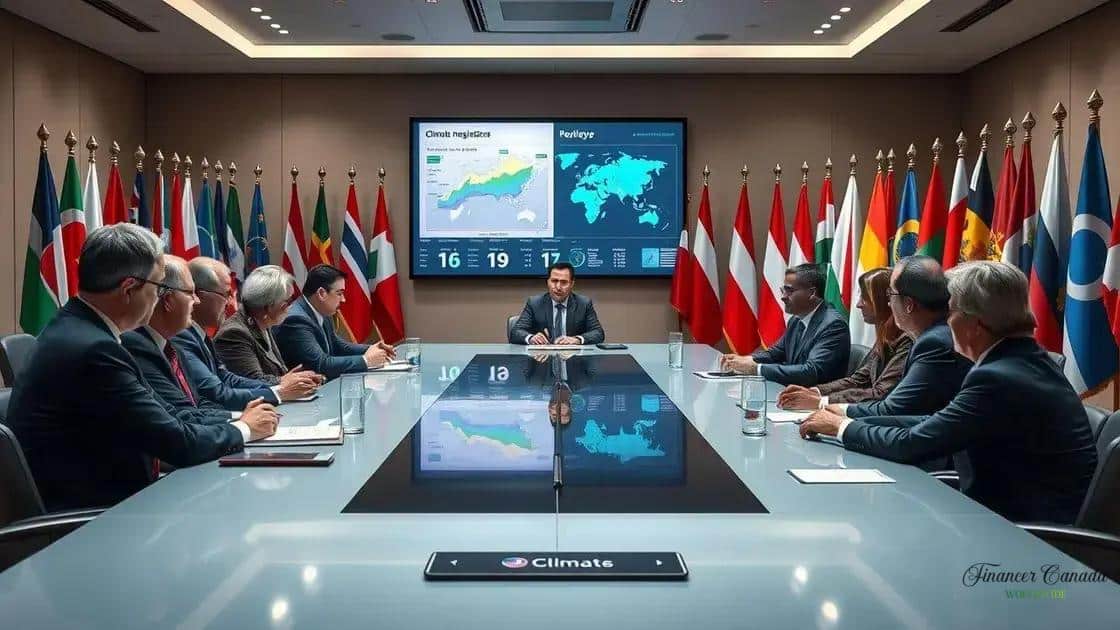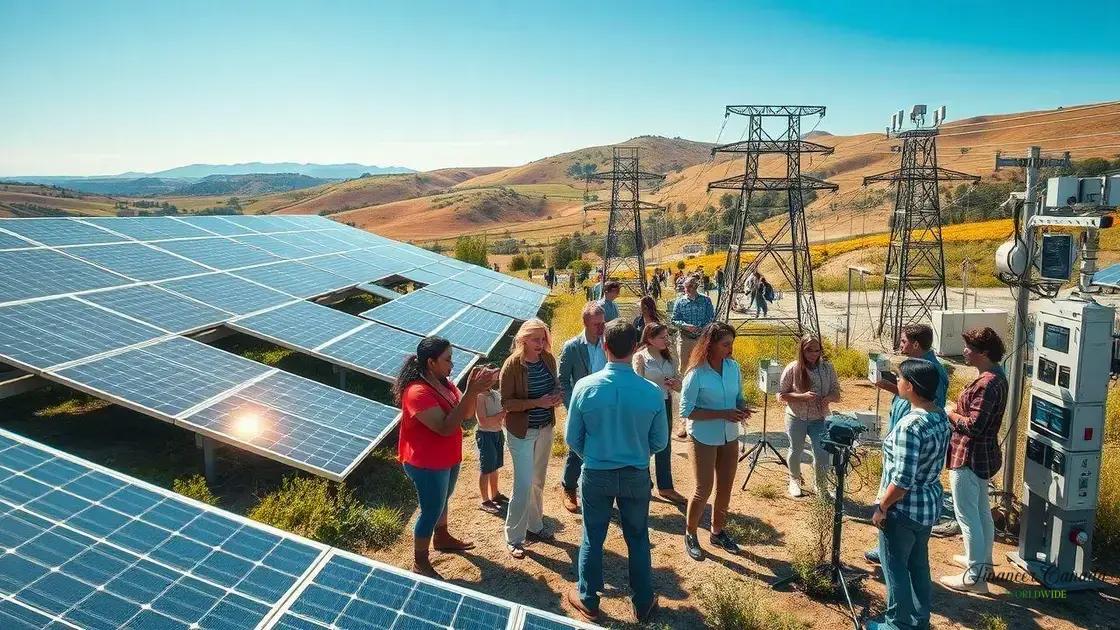Climate change and international policy discussions: what’s at stake?

Climate change and international policy discussions are crucial for coordinating global efforts to limit warming, promote renewable energy, and implement adaptive technologies to ensure a sustainable future.
Climate change and international policy discussions are more intertwined than ever before. Have you ever considered how these conversations shape our planet’s future? Let’s delve into the evolving dynamics in this critical arena.
Understanding the impact of climate change
Understanding the impact of climate change is essential for grasping how our world is changing. As temperatures rise and weather patterns shift, we see more extreme events occurring. But what does this really mean for our daily lives?
The effects of climate change are vast and varied. From melting glaciers to rising sea levels, the consequences are already visible. In urban areas, we can expect more heatwaves that challenge public health. In rural regions, droughts can lead to crop failures, impacting food supply.
Key impacts to consider:
- Increased frequency of natural disasters
- Loss of biodiversity and habitats
- Health issues among vulnerable populations
- Economic strain and job losses in affected sectors
As climate change progresses, we are witnessing its profound effects on ecosystems. Species are forced to adapt or face extinction. Coral reefs, for example, experience bleaching due to temperature rises, which affect marine biodiversity.
Another aspect of climate change involves its impact on water resources. Communities worldwide may struggle with water scarcity. This challenge can lead to conflicts over water rights and affect agricultural practices.
Long-term implications include:
- Displacement of people due to rising sea levels
- Changes in migration patterns
- Increased insurance costs
- Challenges in maintaining infrastructure
Through all these effects, climate change remains a pressing issue that demands collective action. Understanding these impacts helps to engage more individuals in conversations on how to combat this challenge.
Key international policy frameworks

Understanding the key international policy frameworks is crucial for addressing climate change effectively. Various agreements and frameworks guide global efforts, helping countries coordinate their responses and share responsibilities.
One major agreement is the Paris Agreement, which aims to limit global warming to well below 2 degrees Celsius. This agreement brings together nations pledging to reduce greenhouse gas emissions in a transparent and balanced manner.
Important components of the Paris Agreement include:
- Nationally Determined Contributions (NDCs) that outline emission reduction targets.
- A framework for financial assistance to developing nations.
- Regular reviews and updates to keep countries accountable.
- Mechanisms for technological support and capacity building.
Another important framework is the UN Sustainable Development Goals (SDGs). These 17 goals include specific targets related to climate action. They guide nations in developing policies that promote sustainability while tackling issues such as poverty and inequality.
Additionally, the Kyoto Protocol was one of the first international agreements addressing climate change. It established legally binding obligations for developed countries to reduce their emissions. Although it had limitations, it set the stage for more comprehensive agreements.
Other relevant frameworks are:
- The Montreal Protocol, which successfully phased out ozone-depleting substances.
- The Convention on Biological Diversity, emphasizing the link between biodiversity and climate.
- Regional agreements that address specific climate challenges in various areas.
Each of these frameworks plays a significant role in uniting countries to combat climate change. By adhering to these policies, nations can work together for a sustainable future.
Negotiations: successes and challenges
The dynamics of negotiations in climate policy present both remarkable successes and significant challenges. Over the years, many international meetings have aimed at uniting countries to tackle climate change effectively. Understanding these negotiations is key to grasping how global cooperation unfolds.
A primary success can be seen in the establishment of the Paris Agreement. This historic agreement brought together nearly all nations in a pledge to take action against climate change. It created a framework where countries committed to setting their own goals for reducing emissions, known as Nationally Determined Contributions (NDCs).
However, various challenges persist:
- Disparities in resources and capabilities between developed and developing countries.
- Insufficient motivation to meet set targets without mandatory enforcement.
- Political conflicts that may hinder consensus.
- Withdrawal of key countries from agreements, affecting collective goals.
Another significant achievement was the success of the Montreal Protocol, which phased out substances that deplete the ozone layer. The protocol showcases how a united global front can lead to environmental restoration. Many countries came together, recognizing that the health of the planet was at stake.
Yet, while there are successes, the path to unified action is not smooth. The impact of climate change is often felt unevenly across nations, causing reluctance in some to commit to costly measures. Additionally, ongoing economic challenges can lead to prioritizing short-term growth over long-term sustainability.
To address these challenges, participants focus on:
- Enhancing financial aid to developing nations.
- Implementing innovative technologies to aid compliance.
- Building trust through transparent communication.
- Creating incentive structures that encourage timely action.
As nations continue to negotiate, the importance of collaboration remains vital. Every failure and success in these negotiations serves as a lesson moving forward, shaping strategies that reinforce global commitments against climate change.
The role of technology in policy adaptation

The role of technology in policy adaptation is becoming increasingly important as we tackle climate change. Technology offers tools and solutions that can help nations meet their climate goals more effectively. Innovations in various fields are enabling policymakers to devise more robust strategies.
For example, renewable energy technologies, such as solar and wind power, have transformed how we produce energy. These technologies reduce reliance on fossil fuels, significantly cutting greenhouse gas emissions. By integrating these renewable sources into national energy plans, countries can adapt their policies to foster sustainable development.
Key technological advancements include:
- Smart grids that enhance energy efficiency and management.
- Carbon capture and storage systems to reduce emissions from industrial sources.
- Advanced climate modeling tools that improve predictive capabilities.
- Blockchain technology for transparent climate finance tracking.
Moreover, technology facilitates better data collection. Improved sensors and satellites allow for real-time monitoring of environmental changes. This data informs policymakers on how to adjust strategies based on current conditions and future projections. Such adaptability is crucial in a rapidly changing climate.
Additionally, communication technologies foster international collaboration. Virtual platforms enable countries to share data and best practices seamlessly. This sharing of knowledge enhances collective responses to climate challenges, amplifying the effectiveness of global agreements.
Challenges of integrating technology include:
- Financial constraints in developing nations for adopting new technologies.
- Cybersecurity risks that could hinder data integrity.
- Regulatory hurdles that slow down innovation.
- Equity issues regarding access to technology.
Despite these hurdles, the integration of technology into climate policy is essential. By embracing these innovations, countries can not only adapt to climate change but also lead the way in creating a sustainable future.
Future outlook: what can be done?
The future outlook on climate change is both challenging and hopeful. As the impacts of climate change become more pronounced, it’s essential to understand what actions can be taken to mitigate its effects. The path forward requires global cooperation, innovative solutions, and a commitment to change.
One promising avenue is the transition to renewable energy sources. Investing in solar, wind, and hydroelectric power can significantly reduce greenhouse gas emissions. These technologies not only help in combating climate change but also create new job opportunities in emerging industries.
Key steps to consider include:
- Enhancing energy efficiency in buildings and transportation.
- Implementing policies that promote sustainable agricultural practices.
- Encouraging public transportation and the use of electric vehicles.
- Investing in research and development for new clean technologies.
Additionally, reforestation and afforestation initiatives can play a vital role in absorbing carbon dioxide from the atmosphere. Protecting existing forests is equally important, as they serve as critical carbon sinks and biodiversity reserves. Communities around the world are already working on local projects to restore ecosystems and enhance resilience against climate impacts.
Another focus area is climate education and awareness. By informing and empowering individuals, communities can engage in collective efforts to reduce their carbon footprints. Grassroots movements and local initiatives are crucial for driving change at the community level.
Collaboration among various stakeholders is essential:
- Governments must create favorable policies and regulations.
- Businesses should adopt sustainable practices and technologies.
- Civil society can advocate for policies and hold leaders accountable.
- International organizations play a role in facilitating global agreements and resource sharing.
The road ahead will be filled with challenges, but by working together and embracing innovative solutions, we can create a sustainable future. Investing in our planet today will pay dividends for generations to come.
In conclusion, addressing climate change requires immediate and collective action. With various international policies and agreements, we are at a turning point to create a sustainable future. By leveraging technology, collaborating across sectors, and promoting renewable energy, we can make significant strides. Engaging communities through education and grassroots efforts is essential to build momentum. Ultimately, our dedication today will determine the health of our planet for generations to come.
FAQ – Frequently Asked Questions about Climate Change and Policy
What are the main goals of the Paris Agreement?
The Paris Agreement aims to limit global warming to well below 2 degrees Celsius by encouraging countries to set their own emission reduction targets.
How can technology help address climate change?
Technology can provide innovative solutions, such as renewable energy sources and advanced monitoring systems, which improve the effectiveness of climate policies.
Why is community engagement important in climate action?
Community engagement fosters awareness and encourages collective action, empowering individuals to reduce their carbon footprint and push for sustainable practices.
What role do developing countries play in climate negotiations?
Developing countries face unique challenges, but they play a crucial role in negotiations by advocating for financial and technological support to implement sustainable solutions.





